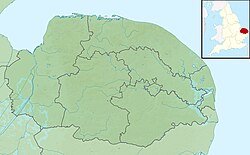| Caister Volunteer Lifeboat Station | |
|---|---|
 Caister Volunteer Lifeboat Station. | |
| General information | |
| Type | Lifeboat Station |
| Location | Skippers Walk, Caister-on-Sea, Norfolk, NR30 5DJ, England |
| Coordinates | 52°38′45.9″N1°44′09.9″E / 52.646083°N 1.736083°E |
| Opened | NASLSM 1845 RNLI 1857 CVLS 1969 |
| Website | |
| www | |
Caister Volunteer Lifeboat Service, or Caister Lifeboat, is based at Caister-on-Sea in Norfolk, and operates one of only three offshore lifeboats in the UK that are independent of the RNLI. [1] [2]
Contents
- History
- Sinking of the Zephyr
- 1901 Caister lifeboat disaster
- RNLI and independent status
- Coxswain Roland "Benny" Read
- Collection box
- Station honours
- List of coxswains
- Caister CVLS lifeboats
- All-weather lifeboats
- Inshore lifeboats
- See also
- References
- Further reading
- External links
A lifeboat at Caister was first documented in 1791, being used by the Caister Beach Company to salvage ships wrecked on the sand banks offshore from Caister. Between 1856 and 1969 lifeboats at Caister were operated by the RNLI.
The station currently operates a 14 m (46 ft) Medina-class offshore lifeboat, CVLS 45-01 Annette Thurlow, and a 7 m (23 ft) long Alicat Inshore lifeboat, Fred Dyble II.
Caister Volunteer Lifeboat Service is a registered charity (No. 262126), supported entirely by public donation. It has 'Declared Facility' status with H.M. Coastguard, and is a member of the National Independent Lifeboats Association (NILA). [3] [4] [5]

